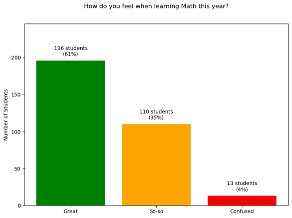Second Year of Building Confidence Through Numeracy
Using data from our previous school year’s progress, the Mitchell FESL team has established that we are ready to move to the next phase of our plan to build confidence through numeracy. Last year, we focused on play-based learning, using hands-on materials to make learning interactive, strategic and fun. We will continue this approach as it has proven successful with our students. Students are letting us know that they are less anxious about Math and enjoy it more than before. However, we notice that many students still have difficulty demonstrating the skills they have acquired, and specifically, are finding it difficult to use Math language to verbalize strategies and learning. This is the data Mitchell staff has used to better understand the needs of our community:
FSA data – Numeracy Proficiency


This data shows us that overall, our grade 4 and 7 students showed stronger proficiency in numeracy last school year after we started our new numeracy school goal. As the FSA assessment takes place in October, when we had just started to act towards our new goal, we aren’t assuming that these improvements are necessarily all connected to our school plan. However, a hunch is that students may have felt more confident in taking a risk and trying a response on the test, rather than leaving it blank. We will continue monitoring FSA numeracy data this year to compare and have a better sense of the impact of our actions on numeracy proficiency for our students.
Report Card Data

This data indicates that teacher-assessed proficiency has not changed much, if at all, since starting our new goal. We are hoping that developing our communication skills around numeracy will support student’s abilities to demonstrate their learning.
Surveying Data
- We surveyed staff at the start and at the end of the school year in 2024/2025. We wanted to know their confidence levels in teaching numeracy and Math concepts. In June, teaching staff data indicated that teachers feel more confident explaining the relationship between Math and Numeracy and that they feel more confident in their knowledge of the Math curriculum. They are also more confident and comfortable in their knowledge of instructional routines and pedagogical approached related to Math. One area that most teachers recognize as still developing is their understanding and familiarity of the Numeracy Foundations. Assessment of proficiency was also an area of interest for further professional development for many staff members.
- We also surveyed students in the Spring of 2025. We used the Ministry Student Learning Survey to get Grade 4 and 7 students’ opinions. See the results below:


Overall, these results are positive and indicate a good impact on student learning, confidence and pleasure in Math. We are hoping that being able to use common mathematical language will help our students feel more confident and enjoy Math more.
- In the Spring 2025, we surveyed all students, asking them: “How do you feel when learning Math this year?” See results below:

Grade by grade data showed a trend where students’ level of confidence in Math is higher in the primary grades and starts to dwindle in the intermediate grades. This is good information for target intervention this school year, highlighting the need for better Math language skills as Math becomes more “wordy” through the upper grades.
- In the same survey, we also inquired about learning preferences. When asked “What helps you learn Math well?”, students’ top 3 answers were:
- Playing games (126 students)
- Group work (116 students)
- Teacher help (110 students)
This is in alignment with the strategies deployed last year to build confidence through numeracy.
When asked “What do you want to do more of in Math?”, students’ top 3 answers were:
- Playing games (134 students)
- Group work (109 students)
- Worksheets (87 students)
This is good feedback to support our work next year. It is important to note that students still see value in a more traditional approach to learning Math, which supports our hunch that a balance of playful, hands-on and problem-based work best supports our students’ needs in Math.
Based on the data accumulated through the year, we assess that we have made strong progress in our goal of “Building Confidence Through Numeracy” last year.
This data was revisited with staff in the Fall of 2025 to decide on next steps and where to take our numeracy goal. This is how we have decided to continue our efforts with play-based, experiential Math learning while adding a focus on common Mathematical language. We also feel that focussing on language will be supportive of our high ELL population, as they develop more scientific language around Math. Here are some of the steps we have committed to, to support our goals this year:
- Continue to provide professional development opportunities for staff to develop knowledge around Math/Numeracy curriculum, teaching and assessing strategies.
- Learn more about formative Math assessments that we could lead school-wide to learn more about students’ learning needs and use as a guide to planning for the year.
- Continue to involve our parent community through Principal’s Monthly Review, PAC meetings and possibly, a Math Festival evening.
- In committee, develop a Math language continuum to be used school-wide, as well as develop recommendations on how to teach these terms to our students (strategies, games, visuals, etc.) This will be completed with the guidance of our Math teacher consultant.